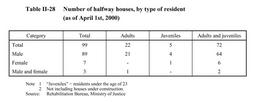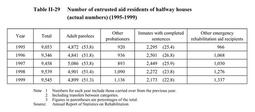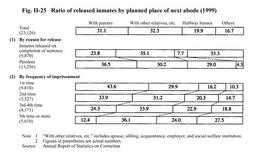| Previous Next Index Image Index Year Selection | |
|
|
2 Trends in continuous aid services Halfway houses are either established separately for men and women and for adults and juveniles, or accommodate these separately within the same house. Table II-28 shows the number of halfway houses as of April 1st, 2000, by type of resident(excluding hostels currently under construction).
Table II-28 Number of halfway houses, by type of resident (as of April 1st, 2000) Halfway houses assist residents by providing accommodation, meals, employment assistance, counseling and advice, and so on. Residents may be (1) probationers or parolees or recipients of emergency rehabilitation aid whose care has been entrusted by probation offices (entrusted aid), or (2) those who apply for aid in person when entrusted aid has been terminated, etc., due for example to expiration of the stipulated period of emergency rehabilitation aid (voluntary aid).Table II-29 shows the number of entrusted aid residents of halfway houses over the last 5 years (actual numbers), by type of resident. Table II-29 Number of entrusted aid residents of halfway houses (actual numbers)(1995-1999) Fig. II-25 shows the component ratio of inmates released from correctional institutions in 1999, by planned place of next abode. The proportion of those whose place of next abode is a halfway house is higher for parolees than for inmates released on completion of their sentence. The use of halfway houses as a place of next abode also increases in proportion to the frequency of imprisonment.Fig. II-25 Ratio of released inmates by planned place of next abode (1999) |


